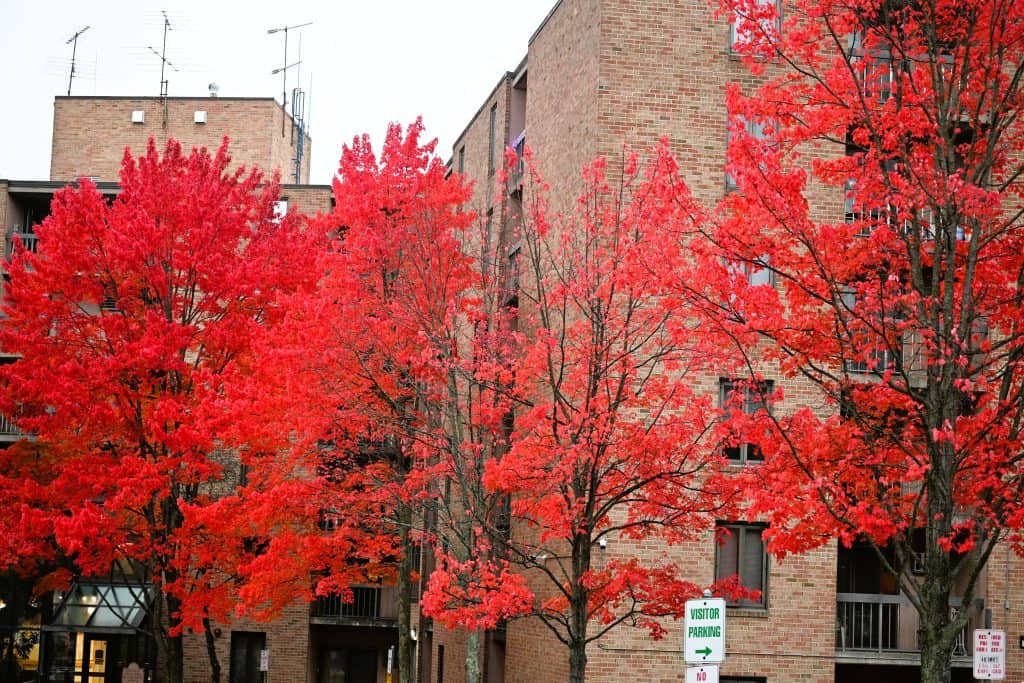Here’s what’s blooming in town this week to make your walks more enjoyable
By Laura Eisener
Wednesday’s moon was the largest supermoon of the year. November’s full moon is known as the beaver moon, since it occurs at the season when beavers are adding more branches to strengthen their lodges for winter.
The strong winds of last Friday – Halloween – brought down many leaves from the trees. Many people spent hours raking. Fallen leaves can still be seen in many places. While some trees have lost most or even all of their foliage, there is still brilliant color in the branches of others this week.
Despite the Halloween winds, one of the trees still holding most of its leaves into November is the maidenhair tree or ginkgo (Ginkgo biloba) behind the old fire station near the back corner of Town Hall. Ginkgos are known for their very distinctive fan shaped foliage. While there are many other ginkgo trees in town with a more upright shape, this particular tree is a variety propagated by cuttings to pass on its unusually wide shape. The crown shape results from numerous branches growing from a dense cluster of buds, known as a “witch’s broom.” Some witch’s broom growths are caused by diseases or insects, while others are mutations. In the case of the ginkgo, it was caused by a mutation. The one near Town Hall is a perfect example of the variety known as Ginkgo ‘Witch’s Broom’ with its dramatic wide shape and the very vivid yellow fall color. This variety is a male or non-fruiting clone, which is usually preferable since ginkgo fruits have an unpleasant odor.
It is still delightful to walk around town and see carved pumpkins from Halloween. Since they don’t tend to last very long once carved, most often people wait until very close to Halloween, or even until the day itself, to carve their pumpkins. Uncarved ones can last well into the winter, and many people transition their pumpkins into Thanksgiving/harvest displays or make them into pies and other traditional fall feast ingredients. If we don’t eat them, the squirrels eventually will, although they don’t usually start burrowing into the pumpkins for seeds until after a hard frost.
Despite the falling leaves, the growing season is not completely over. Dee LeMay’s fragrant pink “Forever and Ever” rose has bloomed for about a decade. This particular hybrid produces the fruits known as rose hips, which contain seeds. This year one of those seeds developed into a new small plant, which she potted up to protect it from rabbits and any other threats, and the tiny plant produced a bud that blossomed this week. Depending on weather, this semi-double variety may continue blooming into December.
Meanwhile in my own garden on the other side of town, the ‘Bernice’ iris that bloomed in June sent up another stalk with seven or more buds about a month ago, and it is now blooming for a third time. Unfortunately, when I went out late on Halloween afternoon, I discovered that the strong wind had broken the stalk at the base, so I now have it in a vase inside the house. It’s no longer in view of people walking by, but it gives me the opportunity to enjoy it for more moments in the day.
Editor’s Note: Laura Eisener is a landscape design consultant who helps homeowners with landscape design, plant selection and placement of trees and shrubs, as well as perennials. She is a member of the Saugus Garden Club and offered to write a series of articles about “what’s blooming in town” shortly after the outbreak of the COVID-19 pandemic. She was inspired after seeing so many people taking up walking.


